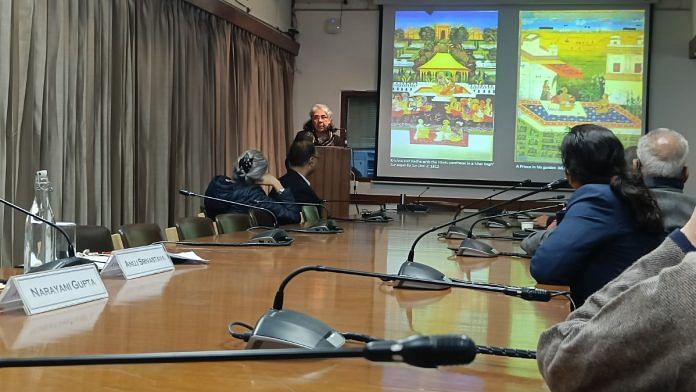New Delhi: The famous Mughal gardens have graced coffee tables, history, and guidebooks. So much is known about them that they’ve overshadowed the neighbouring desert gardens of Rajasthan.
Priyaleen Singh, professor at the School of Planning and Architecture (SPA), attempted to correct this imbalance in her lecture ‘Evoking the Sounds and Scents of Monsoon in the Gardens of Rajasthan’ at Delhi’s India International Centre on 16 January. She drew on the gardens of Deeg, Saheliyon ki Bari in Udaipur, Jal Mahal in Nagaur, and Rani Padmini’s palace in Chittor to show how Rajasthan’s gardens in the 17th and 18th centuries captured the spirit of the monsoon while conveying a valuable message on ecology.
The gardens were really a celebration of life, through the celebration of nature, seasons and water, said Singh. Unlike the contemporary landscape design in India, often largely reduced to a monotonous, or at times gimmicky visual experience, Rajput gardens present enriching experiential aesthetics.
With the notes of Megh Malhar, playing in the background to evoke the romance of the rains, Singh explored how the gardens were symbols of stability and prosperity for both the Mughals and the Rajputs.
The water garden of Saheliyon ki Bari in Udaipur is a green marvel. The pavilion designed with a double roof slab lifted water up through pipes concealed in the columns to eventually create the effect of a cascade of rain.
The garden at Rajasthan’s Deeg exemplified the joy of monsoon. The design successfully combined the concept of the Jal Mahal, or water palace, with the Char Bagh layout of a formal Mughal garden.
“The textures of the sky, colours, fragrances—we got a wonderful sense of that,” said historian Narayani Gupta, who was part of the panel discussion with Singh, Rima Hooja, managing trustee at Jaipur Virasat Foundation and Anuj Srivastava, architect, and writer at Delhi’s India International Centre (IIC).
Gardens, she argued, are as much a record of a city’s history and synchronicity as its architecture, monuments and relics.
“Our city has a Rajput element in its Mughal past. And Delhi’s long history can be read, not only as a narrative of rule by a series of dynasties, but as a point of convergence in different landscapes,” said Gupta.
Also read: Is Delhi really a city of gardens? Mughals, British & CPWD laid them very differently
Aesthetics of Rajput gardens
The transition of seasons in music, poetry, art and eventually to garden design is evident in the paintings of the 16th century.
Due to the scarcity of water in the desert state, the gardens were designed to give the illusion of rain even during the dry months. Singh called this the “Bud Bude” arrangement. Water bubbled up through a perforated slab placed over a water basin fed by a system of pipes, which generated enough force to produce the murmur of moving water.
“With frequent droughts, this extravagance was perhaps born out of a desire to evoke the memory of the monsoon through water—both during the season and in its absence,” Singh said, adding that this arrangement still survives in the garden at Mursagar in Jaisalmer.
In a way, the design of these gardens was a reflection or an extension of how the people of Rajasthan were constantly mediating between frugality and lavishness.
“The grandest engagement with water seen in Rajasthan is in the design of the water garden, a trend that started in Rani Padmini’s palace at Chittor. It evolved in the case of Kyari at Amer and culminated in the lake palace tradition at the Jag Niwas and Jag Mandir in Udaipur,” she said.
According to Singh, the 16th century Vaishnav poetry as well as the geographical location of Braj—the mythical land of Krishna, sited within the territorial boundaries of the cultural landscape of Rajasthan, influenced the aesthetics of the time.
“The garden was an assertion of the local culture, where the Vaishnavite impact is still discernible in the names of the various palace structures within the gardens, such as Gopal Bhavan, Kishan Bhavan, Nand Bhavan, all of which are names of Krishna, the mythical hero,” she said.
But the gardens of Udaipur were different from those of Jaisalmer. This is where culture, geography and landscape come into play.
“They were different due to the topographic and climatic compositions of their territorial location in the western arid and semi-arid parts of India. One was just sheer desert, and the other of course had a bit of water,” she said.
Beyond kings or warriors
For historian Narayani Gupta, gardens, their evolution, and their absorption of influences from England to Japan, are an integral part of a city’s history. She would like to see textbooks go beyond kings, warriors and treaties to celebrate gardeners and horticulturalists as well.
“They should be concerned with those with creative talent who supplemented the work of nature,” she said, adding that in courses of history, civics art innovations are not studied. Ecological history, architectural history, and garden history, should be present all through school courses, she argued. “These themes are best nourished among children, who are closer because of age and size to the Earth, to plants and trees.”
From the 1900s, Gupta said, gardens were laid out around archaeological sites in most of North India, removing human habitations in many cases.
“In recent years, in effect of over-enthusiasm, some archaeological structures have also been removed,” she said.
(Edited by Ratan Priya)





Rajputs were vegetarians. They probably ate up whatever grew in their gardens. Hence, the lack of attention to Rajput gardens.